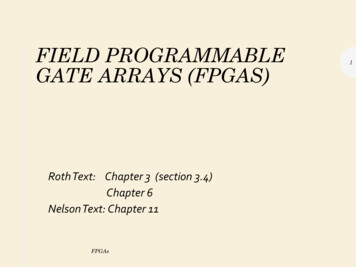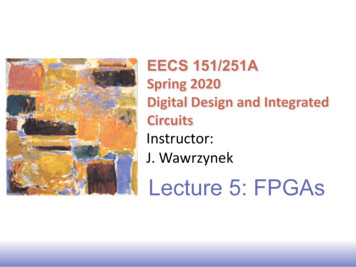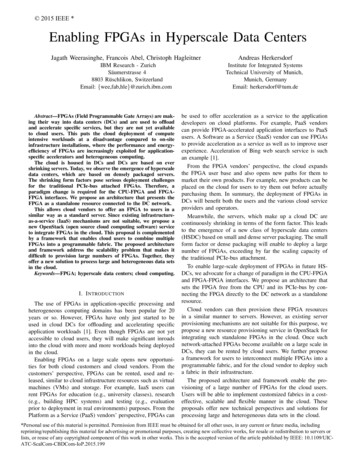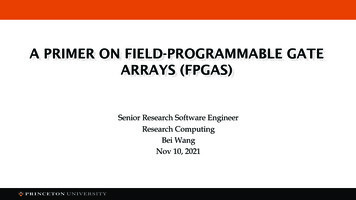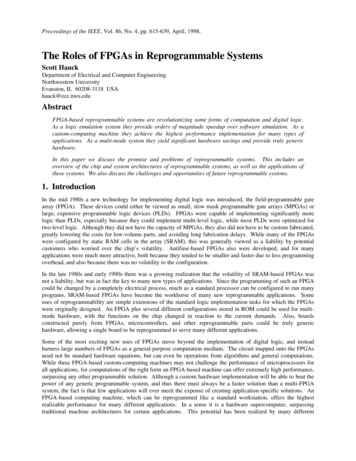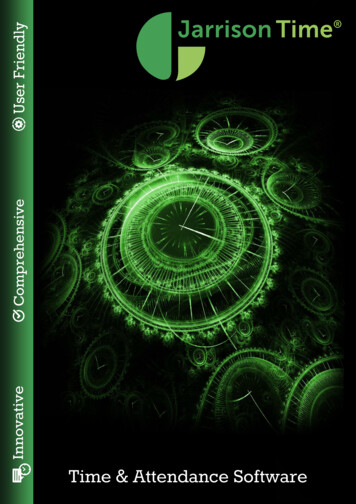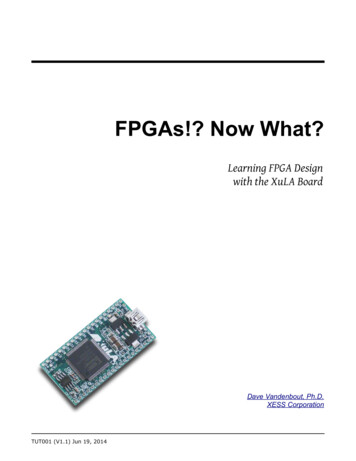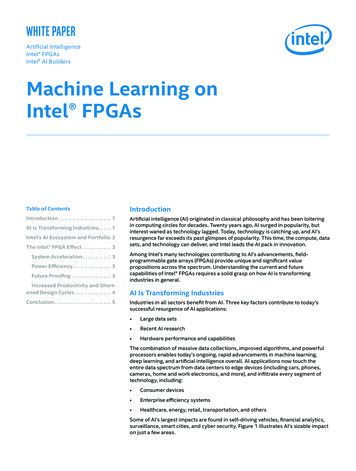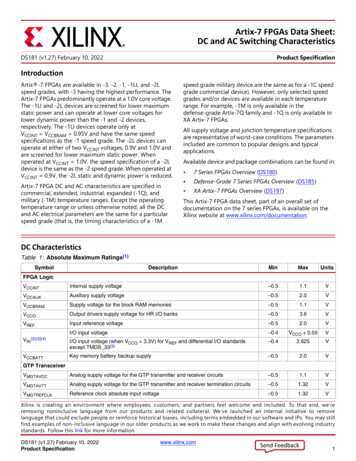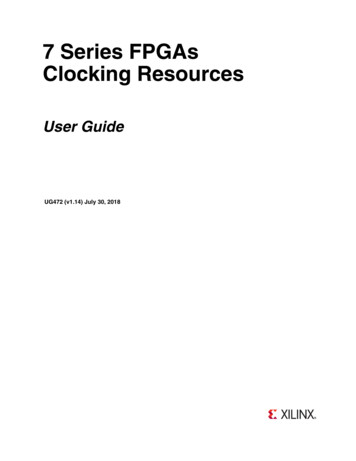
Transcription
7 Series FPGAsClocking ResourcesUser GuideUG472 (v1.14) July 30, 2018
The information disclosed to you hereunder (the “Materials”) is provided solely for the selection and use of Xilinx products. To the maximumextent permitted by applicable law: (1) Materials are made available "AS IS" and with all faults, Xilinx hereby DISCLAIMS ALLWARRANTIES AND CONDITIONS, EXPRESS, IMPLIED, OR STATUTORY, INCLUDING BUT NOT LIMITED TO WARRANTIES OFMERCHANTABILITY, NON-INFRINGEMENT, OR FITNESS FOR ANY PARTICULAR PURPOSE; and (2) Xilinx shall not be liable (whetherin contract or tort, including negligence, or under any other theory of liability) for any loss or damage of any kind or nature related to, arisingunder, or in connection with, the Materials (including your use of the Materials), including for any direct, indirect, special, incidental, orconsequential loss or damage (including loss of data, profits, goodwill, or any type of loss or damage suffered as a result of any actionbrought by a third party) even if such damage or loss was reasonably foreseeable or Xilinx had been advised of the possibility of the same.Xilinx assumes no obligation to correct any errors contained in the Materials or to notify you of updates to the Materials or to productspecifications. You may not reproduce, modify, distribute, or publicly display the Materials without prior written consent. Certain products aresubject to the terms and conditions of Xilinx’s limited warranty, please refer to Xilinx’s Terms of Sale which can be viewed atwww.xilinx.com/legal.htm#tos; IP cores may be subject to warranty and support terms contained in a license issued to you by Xilinx. Xilinxproducts are not designed or intended to be fail-safe or for use in any application requiring fail-safe performance; you assume sole risk andliability for use of Xilinx products in such critical applications, please refer to Xilinx’s Terms of Sale which can be viewed atwww.xilinx.com/legal.htm#tos.Automotive Applications DisclaimerAUTOMOTIVE PRODUCTS (IDENTIFIED AS "XA" IN THE PART NUMBER) ARE NOT WARRANTED FOR USE IN THE DEPLOYMENTOF AIRBAGS OR FOR USE IN APPLICATIONS THAT AFFECT CONTROL OF A VEHICLE ("SAFETY APPLICATION") UNLESS THEREIS A SAFETY CONCEPT OR REDUNDANCY FEATURE CONSISTENT WITH THE ISO 26262 AUTOMOTIVE SAFETY STANDARD("SAFETY DESIGN"). CUSTOMER SHALL, PRIOR TO USING OR DISTRIBUTING ANY SYSTEMS THAT INCORPORATE PRODUCTS,THOROUGHLY TEST SUCH SYSTEMS FOR SAFETY PURPOSES. USE OF PRODUCTS IN A SAFETY APPLICATION WITHOUT ASAFETY DESIGN IS FULLY AT THE RISK OF CUSTOMER, SUBJECT ONLY TO APPLICABLE LAWS AND REGULATIONS GOVERNINGLIMITATIONS ON PRODUCT LIABILITY. Copyright 2011–2018 Xilinx, Inc. Xilinx, the Xilinx logo, Artix, ISE, Kintex, Spartan, Virtex, Vivado, Zynq, and other designated brandsincluded herein are trademarks of Xilinx in the United States and other countries. PCI, PCIe, and PCI Express are trademarks of PCI-SIGand used under license. All other trademarks are the property of their respective owners.7 Series FPGAs Clocking Resources User Guidewww.xilinx.comUG472 (v1.14) July 30, 2018
Revision HistoryThe following table shows the revision history for this document.DateVersionRevision03/01/20111.0Initial Xilinx release.03/28/20111.1Updated disclaimer and copyright on page 2. Updated Clocking Architecture Overviewand Figure 2-2. Revised the discussion in Clock-Capable Inputs including addingTable 1-1 and Figure 2-1. Revised some of the Global Clock Buffers descriptions. Revisedthe description under Figure 2-17. Updated the I/O Clock Buffer—BUFIO section.Updated Figure 2-20. Updated the Regional Clock Buffer—BUFR section. Updated thedescription in Table 2-8. Revised Figure 2-23. Added the BUFMRCE to the BUFMRPrimitive section including Figure 2-25. Added BUFHCE to the Horizontal ClockBuffer—BUFH, BUFHCE section. Moved Clock Gating for Power Savings.Updated the MMCMs and PLLs section. Revised the Frequency Synthesis Only UsingInteger Divide section including Figure 3-4. Revised the discussion around adjacentregions in CLKOUT[0:6] – Output Clocks. Updated the examples after Equation 3-11.Moved and revised VHDL and Verilog Templates and the Clocking Wizard.Added Appendix A, Multi-Region Clocking.05/31/20111.2Added section on 7 Series FPGAs Clocking Differences from Previous FPGAGenerations.Updated Figure 2-2. Clarified discussion in Clock-Capable Inputs section includingremoving Table 1-1: Migration of devices in the same package with different top/bottomalignments. Redrew Figure 2-4, Figure 2-16, Figure 2-18, and Figure 2-22.Updated description of CLKOUT[0:6] in Table 3-5. Updated CLKFBSTOPPED –Feedback Clock Status, page 83. Clarified the MMCM/PLL relationship includingupdating Figure 3-10. Added more information to the Phase Shift section, includingEquation 3-5.Revised Figure A-6 and Figure A-7. Added Appendix B, Clocking Resources andConnectivity Variations per Clock Region.10/27/20111.3Moved 7 Series FPGAs Clocking Differences from Previous FPGA Generations. AddedClock Buffer Selection Considerations. Clarified description in Clock-Capable Inputs.Added another note after Figure 2-22, page 53. Added the Stacked Silicon InterconnectClocking section.Updated Figure 3-6, page 73. Clarified descriptions in Frequency Synthesis UsingFractional Divide in the MMCM, page 73, Interpolated Fine Phase Shift in Fixed orDynamic Mode in the MMCM, page 75, Determine the Input Frequency, page 76,CLKOUT[0:6] – Output Clocks, page 82, and Reference Clock Switching, page 91.Revised description of STARTUP WAIT, page 85. Updated RST description in Table 3-5,page 78. Updated CLKOUT[0] DIVIDE F(2) allowed values in Table 3-7, page 83.Updated Clock Network Deskew, page 72 adding Figure 3-12, page 92.Updated Table B-1 and added Table B-2.02/16/20121.4Replaced “clocking backbone” with “clock backbone” and “clocking region” with “clockregion” throughout.Added Chapter 1, Clocking Overview, containing 7 Series FPGAs Clocking Differencesfrom Previous FPGA Generations from Chapter 2 and Summary of Clock Connectivityfrom Appendix B. Updated Table 1-1. Removed XC7A8, XC7A15, XC7A30T, andXC7A50T from Table 1-2.Added Clock-Capable Inputs. Updated Global Clocking Resources, including BUFMRPrimitive. Updated Horizontal Clock Buffer—BUFH, BUFHCE. Updated paragraphbefore Figure 2-27.UG472 (v1.14) July 30, 2018www.xilinx.com7 Series FPGAs Clocking Resources User Guide
DateVersionRevision02/16/20121.4(Cont’d)In introductory paragraph of High-Performance Clocks, removed description of HPCsconnecting to OSERDES and buffers. Replaced cross reference to UG429, 7 Series FPGAsMigration Methodology Guide, with UG872, Large FPGA Methodology Guide. UpdatedStacked Silicon Interconnect Clocking. Replaced SRL with SLR in Figure 2-29. AddedFigure 2-31.Removed hold block from Figure 3-2. Updated clock frequencies in Frequency SynthesisOnly Using Integer Divide. Replaced 64 with 63 in Equation 3-4. Updated InterpolatedFine Phase Shift in Fixed or Dynamic Mode in the MMCM. Updated pin description ofLOCKED in Table 3-5. Updated LOCKED. In Table 3-7, updated type and allowedvalues of CLKOUT[0] DIVIDE F and CLKFBOUT MULT F, and description ofSTARTUP WAIT and COMPENSATION. In Table 3-8, added STARTUP WAIT andupdated description of COMPENSATION. Replaced GTX with GT in Figure 3-10.Updated Dynamic Reconfiguration Port.Added Appendix B, Clocking Resources and Connectivity Variations per Clock Region.07/13/20121.5Updated paragraph after Figure 1-4. Added bullet about spread spectrum support toKey Differences from Virtex-6 FPGAs. Updated BUFG and BUFH pins, and removedIBUFDS GTE2.O/IBUFDS GTE2.ODIV2 pin from Table 1-1. Updated Table 1-2.Updated note 5 in Table 2-1. Added Figure 2-29.Updated last sentence of Introduction. Updated DO[15:0] – Dynamic ReconfigurationOutput Bus. Added SS EN, SS MODE, and SS MOD PERIOD to Table 3-7. AddedSpread-Spectrum Clock Generation.10/02/20121.6Added note to Table 1-1. Removed XC7A350T and XC7V1500T from Table 1-2.Updated first paragraph of Single Clock Driving Multiple CMTs. Added notes 5 and 8 toTable 2-1. Updated paragraph after Table 2-10.Added Table 3-9 and timing constraint calculations for 25 MHz and 80 MHz inputclocks. In Table 3-10, changed Bandwidth value from N/A to Low, and removedduplicate paragraph after table.Removed XC7A350T from title of Figure B-4.04/03/20131.7Updated Figure 1-3, Figure B-2, and Figure B-3. Added BUFMR to Table 1-1. Updatedsecond paragraph in Dynamic Phase Shift Interface in the MMCM. Added note toTable 2-7.08/07/20131.8Updated Table 1-2 and Table 3-7. Updated the figure titles for Figure B-2 and Figure B-3.Updated Clock Buffer Placement.04/08/20141.9Updated Clock-Capable Inputs and Dynamic Phase Shift Interface in the MMCM.Updated allowed values and the default value for CLKFBOUT MULT in Table 3-8.05/24/20141.10Changed the value of minimum clock regions from six to four in Clocking ArchitectureOverview. Added information to MGTREFCLK0 in Table 1-1. Added section on GTZLoopback Clock Buffer — BUFG LB (HT devices only) to Chapter 2. Changeddescription of REF JITTER1 and REF JITTER2 in Table 3-7 and Table 3-8. Updated firstparagraph in Use Cases.11/19/20141.11Removed general interconnect from this bulleted list on page 49. Updated the figuretitles for Figure B-2 and Figure B-3.03/04/20151.11.1Updated Frequency Synthesis Using Fractional Divide in the MMCM, page 73 bychanging 0.125 degrees to 0.125.06/12/20151.11.2Fixed broken link in three references to 7 Series FPGA Data Sheets on page 73 and page 74.09/27/20161.12Added the Spartan-7 FPGAs and the Artix-7 (XC7A12T and XC7A25T) devices whereapplicable including updating Appendix B. Updated the BUFR Alignment section.Updated the Automotive Applications Disclaimer.7 Series FPGAs Clocking Resources User Guidewww.xilinx.comUG472 (v1.14) July 30, 2018
DateVersion03/01/20171.13Updated the BUFR Alignment section.07/30/20181.14Updated the example in Determine the Input Frequency section.UG472 (v1.14) July 30, 2018Revisionwww.xilinx.com7 Series FPGAs Clocking Resources User Guide
7 Series FPGAs Clocking Resources User Guidewww.xilinx.comUG472 (v1.14) July 30, 2018
Table of ContentsRevision History . . . . . . . . . . . . . . . . . . . . . . . . . . . . . . . . . . . . . . . . . . . . . . . . . . . . . . . . . . . . . 3Preface: About This GuideGuide Contents . . . . . . . . . . . . . . . . . . . . . . . . . . . . . . . . . . . . . . . . . . . . . . . . . . . . . . . . . . . . . 11Additional Resources . . . . . . . . . . . . . . . . . . . . . . . . . . . . . . . . . . . . . . . . . . . . . . . . . . . . . . . 11Chapter 1: Clocking OverviewClocking Architecture Overview . . . . . . . . . . . . . . . . . . . . . . . . . . . . . . . . . . . . . . . . . . . . 13Clock Routing Resources Overview . . . . . . . . . . . . . . . . . . . . . . . . . . . . . . . . . . . . . . . . . 13CMT Overview . . . . . . . . . . . . . . . . . . . . . . . . . . . . . . . . . . . . . . . . . . . . . . . . . . . . . . . . . . . 14Clock Buffers, Management, and Routing . . . . . . . . . . . . . . . . . . . . . . . . . . . . . . . . . . . . 157 Series FPGAs Clocking Differences from Previous FPGA Generations . . . . . 21Key Differences from Virtex-6 FPGAs . . . . . . . . . . . . . . . . . . . . . . . . . . . . . . . . . . . . . . . 21Key Differences from Spartan-6 FPGAs . . . . . . . . . . . . . . . . . . . . . . . . . . . . . . . . . . . . . . 22Summary of Clock Connectivity . . . . . . . . . . . . . . . . . . . . . . . . . . . . . . . . . . . . . . . . . . . . . 24Clocking Differences in 7 Series FPGAs . . . . . . . . . . . . . . . . . . . . . . . . . . . . . . . . . . . . . . 27Chapter 2: Clock Routing ResourcesClock Buffer Selection Considerations. . . . . . . . . . . . . . . . . . . . . . . . . . . . . . . . . . . . . . . 29Clock-Capable Inputs . . . . . . . . . . . . . . . . . . . . . . . . . . . . . . . . . . . . . . . . . . . . . . . . . . . . . . . 30Single Clock Driving a Single CMT . . . . . . . . . . . . . . . . . . . . . . . . . . . . . . . . . . . . . . . . . . 31Single Clock Driving Multiple CMTs . . . . . . . . . . . . . . . . . . . . . . . . . . . . . . . . . . . . . . . . 31Clock-Capable Input Pin Placement Rules . . . . . . . . . . . . . . . . . . . . . . . . . . . . . . . . . . . . 31Global Clocking Resources . . . . . . . . . . . . . . . . . . . . . . . . . . . . . . . . . . . . . . . . . . . . . . . . . . 35Clock Tree and Nets - GCLK . . . . . . . . . . . . . . . . . . . . . . . . . . . . . . . . . . . . . . . . . . . . . . .Clock Regions . . . . . . . . . . . . . . . . . . . . . . . . . . . . . . . . . . . . . . . . . . . . . . . . . . . . . . . . . . . .Global Clock Buffers . . . . . . . . . . . . . . . . . . . . . . . . . . . . . . . . . . . . . . . . . . . . . . . . . . . . . .Global Clock Buffer Primitives . . . . . . . . . . . . . . . . . . . . . . . . . . . . . . . . . . . . . . . . . . . .Additional Use Models . . . . . . . . . . . . . . . . . . . . . . . . . . . . . . . . . . . . . . . . . . . . . . . . . .3636363846Regional Clocking Resources . . . . . . . . . . . . . . . . . . . . . . . . . . . . . . . . . . . . . . . . . . . . . . . . 48Clock-Capable I/O . . . . . . . . . . . . . . . . . . . . . . . . . . . . . . . . . . . . . . . . . . . . . . . . . . . . . . . .I/O Clock Buffer—BUFIO . . . . . . . . . . . . . . . . . . . . . . . . . . . . . . . . . . . . . . . . . . . . . . . . .BUFIO Primitive . . . . . . . . . . . . . . . . . . . . . . . . . . . . . . . . . . . . . . . . . . . . . . . . . . . . . . .BUFIO Use Models . . . . . . . . . . . . . . . . . . . . . . . . . . . . . . . . . . . . . . . . . . . . . . . . . . . . .Regional Clock Buffer—BUFR . . . . . . . . . . . . . . . . . . . . . . . . . . . . . . . . . . . . . . . . . . . . . .BUFR Primitive . . . . . . . . . . . . . . . . . . . . . . . . . . . . . . . . . . . . . . . . . . . . . . . . . . . . . . . .BUFR Attributes and Modes . . . . . . . . . . . . . . . . . . . . . . . . . . . . . . . . . . . . . . . . . . . . . .BUFR Use Models . . . . . . . . . . . . . . . . . . . . . . . . . . . . . . . . . . . . . . . . . . . . . . . . . . . . . .Regional Clock Nets . . . . . . . . . . . . . . . . . . . . . . . . . . . . . . . . . . . . . . . . . . . . . . . . . . . . . .Multi-Region Clock Buffer—BUFMR/BUFMRCE . . . . . . . . . . . . . . . . . . . . . . . . . . . . .BUFMR Primitive . . . . . . . . . . . . . . . . . . . . . . . . . . . . . . . . . . . . . . . . . . . . . . . . . . . . . .Horizontal Clock Buffer—BUFH, BUFHCE . . . . . . . . . . . . . . . . . . . . . . . . . . . . . . . . . . .GTZ Loopback Clock Buffer — BUFG LB (HT devices only). . . . . . . . . . . . . . . . . . . .49495050525253545455555758High-Performance Clocks . . . . . . . . . . . . . . . . . . . . . . . . . . . . . . . . . . . . . . . . . . . . . . . . . . . 597 Series FPGAs Clocking Resources User GuideUG472 (v1.14) July 30, 2018www.xilinx.comSend Feedback7
Clock Gating for Power Savings . . . . . . . . . . . . . . . . . . . . . . . . . . . . . . . . . . . . . . . . . . . . 59Stacked Silicon Interconnect Clocking . . . . . . . . . . . . . . . . . . . . . . . . . . . . . . . . . . . . . . . 60Placement of Clocking Structures . . . . . . . . . . . . . . . . . . . . . . . . . . . . . . . . . . . . . . . . . . . 62Clock Buffer Placement . . . . . . . . . . . . . . . . . . . . . . . . . . . . . . . . . . . . . . . . . . . . . . . . . . . . 63Chapter 3: Clock Management TileIntroduction . . . . . . . . . . . . . . . . . . . . . . . . . . . . . . . . . . . . . . . . . . . . . . . . . . . . . . . . . . . . . . . . 65MMCMs and PLLs . . . . . . . . . . . . . . . . . . . . . . . . . . . . . . . . . . . . . . . . . . . . . . . . . . . . . . . . 66General Usage Description . . . . . . . . . . . . . . . . . . . . . . . . . . . . . . . . . . . . . . . . . . . . . . . . . . 69MMCM and PLL Primitives . . . . . . . . . . . . . . . . . . . . . . . . . . . . . . . . . . . . . . . . . . . . . . . .MMCME2 BASE and PLLE2 BASE Primitives . . . . . . . . . . . . . . . . . . . . . . . . . . . . . . .MMCME2 ADV and PLLE2 ADV Primitive . . . . . . . . . . . . . . . . . . . . . . . . . . . . . . . . .Clock Network Deskew . . . . . . . . . . . . . . . . . . . . . . . . . . . . . . . . . . . . . . . . . . . . . . . . . . .Frequency Synthesis Only Using Integer Divide . . . . . . . . . . . . . . . . . . . . . . . . . . . . . .Frequency Synthesis Using Fractional Divide in the MMCM . . . . . . . . . . . . . . . . . . . .Jitter Filter . . . . . . . . . . . . . . . . . . . . . . . . . . . . . . . . . . . . . . . . . . . . . . . . . . . . . . . . . . . . . . .Limitations . . . . . . . . . . . . . . . . . . . . . . . . . . . . . . . . . . . . . . . . . . . . . . . . . . . . . . . . . . . . . .VCO Operating Range . . . . . . . . . . . . . . . . . . . . . . . . . . . . . . . . . . . . . . . . . . . . . . . . . .Minimum and Maximum Input Frequency . . . . . . . . . . . . . . . . . . . . . . . . . . . . . . . . . .Duty Cycle Programmability . . . . . . . . . . . . . . . . . . . . . . . . . . . . . . . . . . . . . . . . . . . . .Phase Shift . . . . . . . . . . . . . . . . . . . . . . . . . . . . . . . . . . . . . . . . . . . . . . . . . . . . . . . . . . .Dynamic Phase Shift Interface in the MMCM . . . . . . . . . . . . . . . . . . . . . . . . . . . . . . . . .MMCM Counter Cascading . . . . . . . . . . . . . . . . . . . . . . . . . . . . . . . . . . . . . . . . . . . . . . . .MMCM/PLL Programming . . . . . . . . . . . . . . . . . . . . . . . . . . . . . . . . . . . . . . . . . . . . . . . .Determine the Input Frequency . . . . . . . . . . . . . . . . . . . . . . . . . . . . . . . . . . . . . . . . . . .Determine the M and D Values. . . . . . . . . . . . . . . . . . . . . . . . . . . . . . . . . . . . . . . . . . . .MMCM Ports . . . . . . . . . . . . . . . . . . . . . . . . . . . . . . . . . . . . . . . . . . . . . . . . . . . . . . . . . . . .PLL Ports . . . . . . . . . . . . . . . . . . . . . . . . . . . . . . . . . . . . . . . . . . . . . . . . . . . . . . . . . . . . . . . .MMCM and PLL Port Descriptions . . . . . . . . . . . . . . . . . . . . . . . . . . . . . . . . . . . . . . . .MMCM Attributes . . . . . . . . . . . . . . . . . . . . . . . . . . . . . . . . . . . . . . . . . . . . . . . . . . . . . . . .PLL Attributes . . . . . . . . . . . . . . . . . . . . . . . . . . . . . . . . . . . . . . . . . . . . . . . . . . . . . . . . . . .MMCM Clock Input Signals . . . . . . . . . . . . . . . . . . . . . . . . . . . . . . . . . . . . . . . . . . . . . . . .Counter Control . . . . . . . . . . . . . . . . . . . . . . . . . . . . . . . . . . . . . . . . . . . . . . . . . . . . . . . . . etailed VCO and Output Counter Waveforms . . . . . . . . . . . . . . . . . . . . . . . . . . . . . . 90Reference Clock Switching . . . . . . . . . . . . . . . . . . . . . . . . . . . . . . . . . . . . . . . . . . . . . . . . . . 91Missing Input Clock or Feedback Clock . . . . . . . . . . . . . . . . . . . . . . . . . . . . . . . . . . . . . . 91MMCM and PLL Use Models. . . . . . . . . . . . . . . . . . . . . . . . . . . . . . . . . . . . . . . . . . . . . . . . 91Clock Network Deskew . . . . . . . . . . . . . . . . . . . . . . . . . . . . . . . . . . . . . . . . . . . . . . . . . . . 91MMCM with Internal Feedback . . . . . . . . . . . . . . . . . . . . . . . . . . . . . . . . . . . . . . . . . . . 93Zero Delay Buffer . . . . . . . . . . . . . . . . . . . . . . . . . . . . . . . . . . . . . . . . . . . . . . . . . . . . . . . . . 94CMT to CMT Connection . . . . . . . . . . . . . . . . . . . . . . . . . . . . . . . . . . . . . . . . . . . . . . . . . . 94Spread-Spectrum Clock Generation . . . . . . . . . . . . . . . . . . . . . . . . . . . . . . . . . . . . . . . . . 96MMCM Application Example . . . . . . . . . . . . . . . . . . . . . . . . . . . . . . . . . . . . . . . . . . . . . 101Dynamic Reconfiguration Port . . . . . . . . . . . . . . . . . . . . . . . . . . . . . . . . . . . . . . . . . . . . 101VHDL and Verilog Templates and the Clocking Wizard . . . . . . . . . . . . . . . . . . . . 102Appendix A: Multi-Region ClockingIntroduction . . . . . . . . . . . . . . . . . . . . . . . . . . . . . . . . . . . . . . . . . . . . . . . . . . . . . . . . . . . . . . . 103Clocking Across Multiple Regions . . . . . . . . . . . . . . . . . . . . . . . . . . . . . . . . . . . . . . . . . 104BUFMR Primitive . . . . . . . . . . . . . . . . . . . . . . . . . . . . . . . . . . . . . . . . . . . . . . . . . . . . . . . . 1048Send Feedbackwww.xilinx.com7 Series FPGAs Clocking Resources User GuideUG472 (v1.14) July 30, 2018
Use Cases . . . . . . . . . . . . . . . . . . . . . . . . . . . . . . . . . . . . . . . . . . . . . . . . . . . . . . . . . . . . . . . . . . 105Clock Alignment Across Clock Regions . . . . . . . . . . . . . . . . . . . . . . . . . . . . . . . . . . . . .Single Buffer per Clock Region . . . . . . . . . . . . . . . . . . . . . . . . . . . . . . . . . . . . . . . . . . . .Driving Multiple BUFIOs . . . . . . . . . . . . . . . . . . . . . . . . . . . . . . . . . . . . . . . . . . . . . . .Driving Multiple BUFRs . . . . . . . . . . . . . . . . . . . . . . . . . . . . . . . . . . . . . . . . . . . . . . . .Multiple Buffers Per Clock Region . . . . . . . . . . . . . . . . . . . . . . . . . . . . . . . . . . . . . . . . .Driving Multiple BUFRs (with Divide) and BUFIO . . . . . . . . . . . . . . . . . . . . . . . . . . .Driving Multiple BUFRs (With and Without Divide) . . . . . . . . . . . . . . . . . . . . . . . . . .BUFR Alignment . . . . . . . . . . . . . . . . . . . . . . . . . . . . . . . . . . . . . . . . . . . . . . . . . . . . . . . .106106106107107107109110Appendix B: Clocking Resources and Connectivity Variations perClock Region7 Series FPGAs Clocking Resources User GuideUG472 (v1.14) July 30, 2018www.xilinx.comSend Feedback9
10Send Feedbackwww.xilinx.com7 Series FPGAs Clocking Resources User GuideUG472 (v1.14) July 30, 2018
PrefaceAbout This GuideXilinx 7 series FPGAs include four FPGA families that are all designed for lowest powerto enable a common design to scale across families for optimal power, performance, andcost. The Spartan -7 family is the lowest density with the lowest cost entry point into the7 series portfolio. The Artix -7 family is optimized for highest performance-per-watt andbandwidth-per-watt for cost-sensitive, high-volume applications. The Kintex -7 family isan innovative class of FPGAs optimized for the best price-performance. The Virtex -7family is optimized for highest system performance and capacity.This 7 series FPGAs clocking resources user guide, part of an overall set of documentationon the 7 series FPGAs, is available on the Xilinx website atwww.xilinx.com/documentation.Guide ContentsThis manual contains the following chapters: Chapter 1, Clocking Overview Chapter 2, Clock Routing Resources Chapter 3, Clock Management Tile Appendix A, Multi-Region Clocking Appendix B, Clocking Resources and Connectivity Variations per Clock RegionAdditional ResourcesTo find additional documentation, see the Xilinx website at:www.xilinx.com/support/documentation/indexTo search the Answer Database of silicon, software, and IP questions and answers, or tocreate a technical support WebCase, see the Xilinx website at:www.xilinx.com/support7 Series FPGAs Clocking Resources User GuideUG472 (v1.14) July 30, 2018www.xilinx.comSend Feedback11
Preface:12About This GuideSend Feedbackwww.xilinx.com7 Series FPGAs Clocking Resources User GuideUG472 (v1.14) July 30, 2018
Chapter 1Clocking OverviewThis chapter provides an overview of the 7 series FPGAs clocking, a comparison between7 series FPGAs clocking and previous FPGA generations, and a summary of clockingconnectivity within the 7 series FPGAs. For detailed information on usage of 7 seriesFPGAs clocking resources, see Chapter 2, Clock Routing Resources and Chapter 3, ClockManagement Tile.Clocking Architecture OverviewThe 7 series FPGAs clocking resources manage complex and simple clocking requirementswith dedicated global and regional I/O and clocking resources. The clock managementtiles (CMT) provide clock frequency synthesis, deskew, and jitter filtering functionality.Non-clock resources, such as local routing, are not recommended when designing for clockfunctions. Global clock trees allow clocking of synchronous elements across the device. I/O and regional clock trees allow clocking of up to three vertically adjacent clockregions. CMTs, each containing one mixed-mode clock manager (MMCM) and onephase-locked loop (PLL), reside in the CMT column next to the I/O column.For clocking purposes, each 7 series device is divided into clock regions. The number of clock regions varies with device size, from one clock region in thesmallest device to 24 clock regions in the largest one. A clock region includes all synchronous elements (for instance: CLB, I/O, serialtransceivers, DSP, block RAM, CMT) in an area spanning 50 CLBs and one I/O bank(50 I/Os), with a horizontal clock row (HROW) in its center. Each clock region spans 25 CLBs up and 25 CLBs down from the HROW, andhorizontally across each side of the device.Clock Routing Resources OverviewEach I/O bank contains clock-capable input pins to bring user clocks onto the7 series FPGA clock routing resources. In conjunction with dedicated clock buffers, theclock-capable input bring user clocks on to: Global clock lines in the same top/bottom half of the device I/O clocks lines within the same I/O bank and vertically adjacent I/O banks Regional clock lines within the same clock region and vertically adjacent clock regions CMTs within the same clock region and, with limitations, vertically adjacent clockregions7 Series FPGAs Clocking Resources User GuideUG472 (v1.14) July 30, 2018www.xilinx.comSend Feedback13
Chapter 1:Clocking OverviewEach 7 series monolithic device has 32 global clock lines that can clock and provide controlsignals to all sequential resources in the whole device. Global clock buffers (BUFGCTRL,simplified as BUFG throughout this user guide) drive the global clock lines and must beused to access global clock lines. Each clock region can support up to 12 of these globalclock lines using the 12 horizontal clock lines in the clock region.The global clock buffers: Can be used as a clock enable circuit to enable or disable clocks that span multipleclock regions Can be used as a glitch-free multiplexer to: select between two clock sources switch away from a failed clock sourceAre often driven by a CMT to: eliminate the clock distribution delay adjust clock delay relative to another clockThe horizontal clock buffer (BUFH/BUFHCE) allows access to the global clock lines in asingle clock region through the horizontal clock row. It can also be used as a clock enablecircuit (BUFHCE) to independently enable or disable clocks that span a single clock region.Each clock region can support up to 12 clocks using the 12 horizontal clock lines in eachclock region.Each 7 series FPGA has regional and I/O clock trees that can clock all sequential resourcesin one clock region. Each device also has multi-clock region buffers (BUFMR) that allowregional and I/O clocks to span up to three vertically adjacent clock regions. The I/O clock buffer (BUFIO) drives the I/O clock tree, providing access to clock allsequential I/O resources in the same I/O bank. The regional clock buffer (BUFR) drives regional clock trees that drive all clockdestinations in the same clock region and can be programmed to divide the incomingclock rate. In conjunction with the programmable serializer/deserializer in the IOB (refer to theAdvanced SelectIO Logic Resources chapter in UG471, 7 Series FPGAs SelectIO ResourcesUser Guide), the BUFIO and BUFR clock buffers allow source-synchronous systems tocross clock domains without using additional logic resources. The regional and I/O clock trees in adjacent clock regions and I/O banks can bedriven using the multi-clock region buffer (BUFMR) when used with the associatedBUFR or BUFIO. Up to four unique I/O clocks and four unique regional clocks can be supported in oneclock region or I/O bank.High-performance clock routing connects certain outputs of the CMT to the I/O on a verylow jitter, minimal duty-cycle distorted direct path.Chapter 2, Clock Routing Resources, has further details on global, regional, and I/Oclocks. It also describes which clock routing resources to use for various applications.CMT OverviewEach 7 series FPGA has up to 24 CMTs, each consisting of one MMCM and one PLL. TheMMCMs and PLLs serve as frequency synthesizers for a wide range of frequencies, serveas a jitter filters for either external or internal clocks, and deskew clocks. The PLL contains14Send Feedbackwww.xilinx.com7 Series FPGAs Clocking Resources User GuideUG472 (v1.14) July 30, 2018
Clocking Architecture Overviewa subset of the MMCM functions. The 7 series FPGA clock input connectivity allowsmultiple resources to provide the reference clocks to the MMCM and PLL.7 series FPGAs MMCMs have infinite fine phase-shift capability in either direction and canbe used in dynamic phase-shift mode. MMCMs also have a fractional counter in either thefeedback path or in one output path, enabling further granularity of frequency synthesiscapabilities.The LogiCORE IP clocking wizard is available to assist in utilizing MMCMs and PLLs tocreate clock networks in 7 series FPGA designs. The GUI interface is used to collect clocknetwork parameters. The clocking wizard chooses the appropriate CMT resource andoptimally configures the CMT resource and associated clock routing resources.Chapter 3, Clock Management Tile, includes details on the CMT block features andconnectivity.Clock Buffers, Management, and RoutingThe figures in this section provide a visual and layered explanation of the
7 Series FPGAs Clocking Resources User Guide www.xilinx.com UG472 (v1.14) July 30, 2018 02/16/2012 1.4 (Cont'd) In introductory paragraph of High-Performance Clocks, removed description of HPCs connecting to OSERDES and buffers. Replaced cross reference to UG429, 7 Series FPGAs Migration Methodology Guide, with UG872, Large FPGA Methodology .
